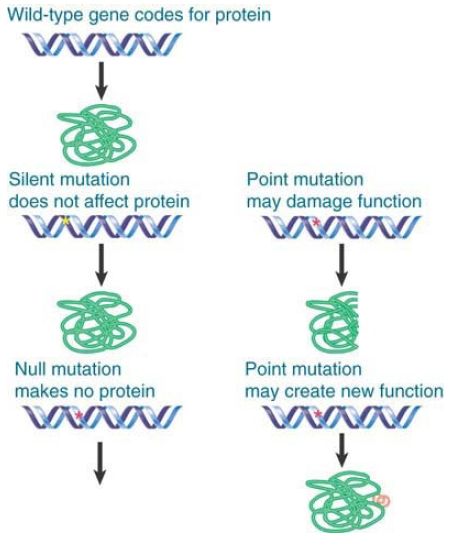
Mutations May Cause Loss of Function or Gain of Function
 المؤلف:
JOCELYN E. KREBS, ELLIOTT S. GOLDSTEIN and STEPHEN T. KILPATRICK
المؤلف:
JOCELYN E. KREBS, ELLIOTT S. GOLDSTEIN and STEPHEN T. KILPATRICK
 المصدر:
LEWIN’S GENES XII
المصدر:
LEWIN’S GENES XII
 الجزء والصفحة:
الجزء والصفحة:
 1-3-2021
1-3-2021
 2508
2508
Mutations May Cause Loss of Function or Gain of Function
KEY CONCEPTS
-Recessive mutations are due to loss of function by the polypeptide product.
-Dominant mutations result from a gain of function, some novel characteristic of the protein.
-Testing whether a gene is essential to survival requires a null mutation (one that completely eliminates its function).
-Synonymous mutations have no phenotypic effect, either because the base change does not change the sequence or amount of polypeptide or because the change in polypeptide sequence has no effect.
The various possible effects of mutation in a gene are summarized in FIGURE 1. In principle, when a gene has been identified, insight into its function can be gained by generating a mutant organism that entirely lacks the gene. A mutation that completely eliminates gene function—usually because the gene has been deleted—is called a null mutation. If a gene is essential to the organism’s survival, a null mutation is lethal when homozygous or hemizygous. Many null mutations might not be lethal but nonetheless disrupt some aspect of the form, growth, or development of the organism, resulting in a specific phenotype.

FIGURE 1. Mutations that do not affect protein sequence or function are silent. Mutations that abolish all protein activity are null. Point mutations that cause loss of function are recessive; those that cause gain of function are dominant.
To determine how a gene affects the phenotype, it is essential to characterize the effect of a null mutation. Generally, if a null mutant fails to affect a phenotype, we can safely conclude that the gene function is not essential. Some genes are duplicated or have overlapping functions, though, and loss of function of one of the genes is not sufficient to significantly affect the phenotype. Null mutations, or other mutations that impede gene function (but do not necessarily abolish it entirely), are called loss-of-function mutations. A loss-of-function mutation is recessive . Loss-of-function mutations that affect
protein activity but retain sufficient activity so that the phenotype is not altered are referred to as leaky mutations. Sometimes, a mutation has the opposite effect and causes a protein to acquire a new function or expression pattern; such a change is called a gainof- function mutation. A gain-of-function mutation is dominant.
Not all mutations in protein-coding genes lead to a detectable change in the phenotype. Mutations without apparent phenotypic effect are called silent mutations. They fall into two categories: (1) base changes in DNA that do not cause any change in the amino acid in the resulting polypeptide (called synonymous mutations); and (2) base changes in DNA that change the amino acid, but the replacement in the polypeptide does not affect its activity (called neutral substitutions).
 الاكثر قراءة في مواضيع عامة في الاحياء الجزيئي
الاكثر قراءة في مواضيع عامة في الاحياء الجزيئي
 اخر الاخبار
اخر الاخبار
اخبار العتبة العباسية المقدسة


